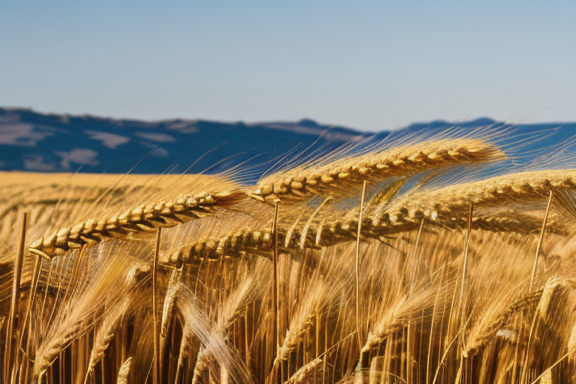The concept of a sheaf can be found in various religious texts, including the Bible. In the Bible, a sheaf often symbolizes abundance, harvest, and blessings. Understanding the significance of a sheaf in the Bible can provide insights into the spiritual and cultural context of the scriptures.
Throughout the Bible, the mention of sheaves often carries profound symbolism and spiritual significance. Let’s explore the deeper meanings associated with sheaves in the biblical context:
Abundance and Harvest
One of the key meanings associated with sheaves in the Bible is abundance. A sheaf represents the bountiful harvest, the plentiful yield that comes as a result of hard work and God’s provision. It symbolizes the abundance of God’s blessings and the rewards of diligence and faithfulness.
“The LORD has done great things for us, and we are filled with joy. Those who sow with tears will reap with songs of joy. Those who go out weeping, carrying seed to sow, will return with songs of joy, carrying sheaves with them.” – Psalm 126:3-6 (NIV)
Offerings and Worship
In the Bible, sheaves are also associated with offerings and worship. During harvest time, the Israelites would bring their firstfruits, including sheaves, as an offering to the Lord. These offerings were a way of expressing gratitude and acknowledging God’s provision. They were also an act of worship, recognizing that everything they had came from God.
“You shall bring the sheaf of the firstfruits of your harvest to the priest, and he shall wave the sheaf before the LORD, so that you may be accepted. On the day after the Sabbath, the priest shall wave it.” – Leviticus 23:10-11 (ESV)
Resurrection and New Life
Another profound symbolism attached to sheaves in the Bible is the concept of resurrection and new life. In the New Testament, Jesus’ resurrection is often compared to a grain of wheat that dies and produces many sheaves. This imagery signifies the hope of eternal life and the promise of a new beginning through Christ.
“Truly, truly, I say to you, unless a grain of wheat falls into the earth and dies, it remains alone; but if it dies, it bears much fruit.” – John 12:24 (ESV)
The symbolism of sheaves in the Bible is rich and multifaceted, reflecting various aspects of life, faith, and God’s provision. From representing abundance and harvest to signifying offerings and worship, sheaves serve as powerful reminders of God’s goodness and the promise of new life. Exploring these symbols can deepen our understanding of biblical narratives and foster a deeper connection with the spiritual truths they convey.

The symbolism of the sheaf in the Bible goes beyond its agricultural significance. It carries spiritual and cultural connotations that enrich the understanding of biblical texts.
Abundance and Harvest
The sheaf represents abundance and the bountiful harvest that God provides. In the Old Testament, the Israelites were instructed to bring a sheaf of the firstfruits of their harvest to the Lord as an offering. This act of gratitude acknowledged God’s provision and recognized that all blessings come from Him. It served as a reminder that God is the ultimate source of abundance and sustenance.
Spiritual Offerings
The presentation of a sheaf as an offering also symbolizes a spiritual offering of oneself to God. Just as the sheaf is offered to God, believers are called to offer their lives and hearts to Him. It represents a surrender of one’s own desires and an acknowledgment of God’s sovereignty. By offering the firstfruits of the harvest, believers express their trust in God’s provision and demonstrate their devotion.
Prophetic Significance
The concept of the sheaf in the Bible also holds prophetic significance. In the New Testament, Jesus is referred to as the “firstfruits” (1 Corinthians 15:20). This designation connects Jesus’ resurrection to the symbolism of the sheaf. Just as the sheaf represented the firstfruits of the harvest, Jesus’ resurrection signifies the firstfruits of the resurrection to eternal life. It foreshadows the future resurrection of believers and the ultimate fulfillment of God’s promises.
Symbol of Unity
Additionally, the sheaf can symbolize unity and the gathering together of the harvest. In the Old Testament, the Israelites were instructed to wave the sheaf before the Lord, signifying the unity of the people and their collective offering. This act highlighted the importance of community and working together in gratitude and worship.
Overall, the symbolism of the sheaf in the Bible encompasses themes of abundance, gratitude, offering, surrender, unity, and prophetic significance. It serves as a reminder of God’s provision, the importance of spiritual offerings, and the ultimate fulfillment of His promises through Jesus Christ.
Biblical References to Sheaf
One of the notable references to a sheaf in the Bible is found in the book of Leviticus. In Leviticus 23:10-11, it is commanded that on the day after the Sabbath following the Passover, an offering of a sheaf of the first grain harvest is to be made to the Lord. This offering is known as the ‘wave sheaf offering’ and marks the beginning of the harvest season.
This act of presenting a sheaf as an offering holds significant symbolism and carries spiritual importance in the biblical context. It serves as a reminder of God’s provision and blessings upon the land, as well as an expression of gratitude and dependence on Him for future harvests.
In ancient agricultural societies, the sheaf represented the first fruits of the harvest. By offering the sheaf to God, the people acknowledged His role as the ultimate provider and sought His favor for a bountiful harvest in the upcoming season. This act of giving back to God was an act of faith and trust in His faithfulness to provide for His people.
Furthermore, the waving of the sheaf before the Lord was a symbolic gesture, signifying the consecration of the entire harvest to God. It was a way of dedicating the entire crop to Him and seeking His blessings and protection over it.


Rockin’ the faith, one verse at a time!
Growing up, the Bible’s stories deeply impacted me. Now, with over 15 years of preaching experience, I blend timeless teachings with modern technology, making them relevant for today’s world.
Bible Hub Verse is my platform to share historical insights and thought-provoking articles, exploring both familiar and uncommon Christian topics. My passion is building a welcoming online space for everyone to learn, grow in their faith, and discover the Bible’s enduring message.
Join the journey!
God bless you.





